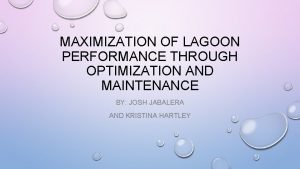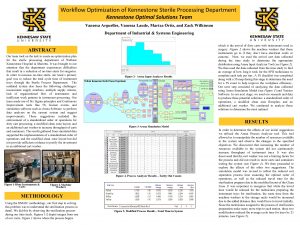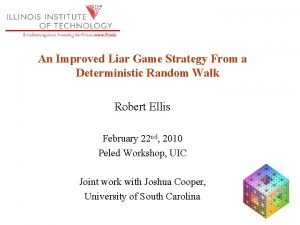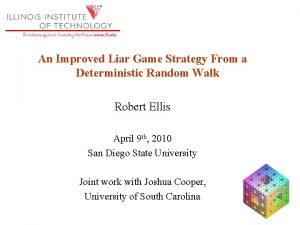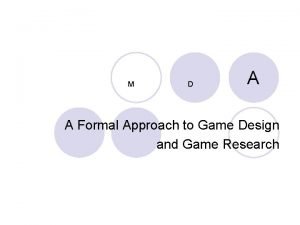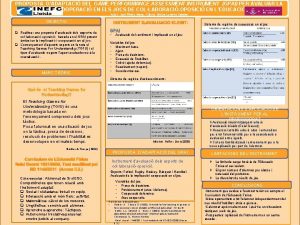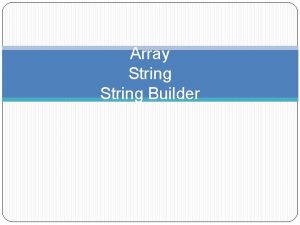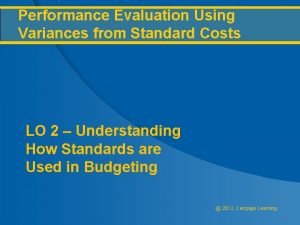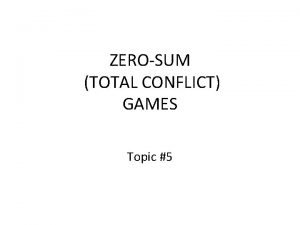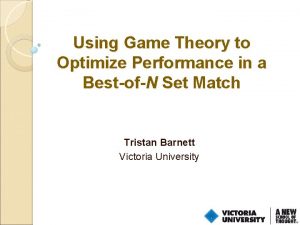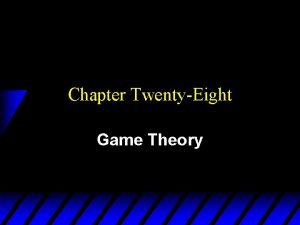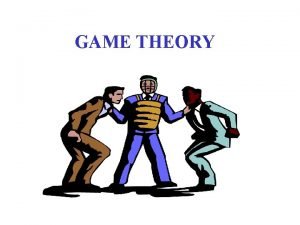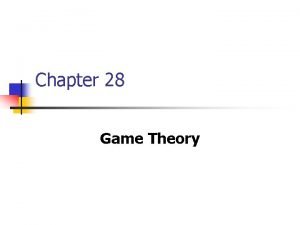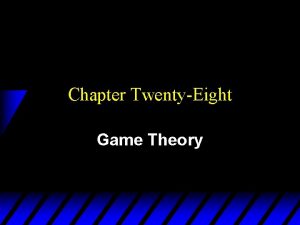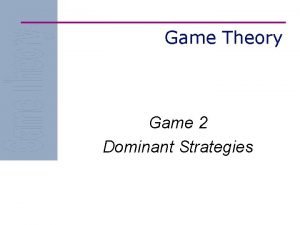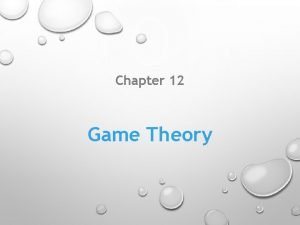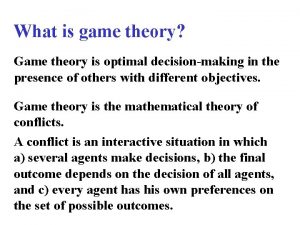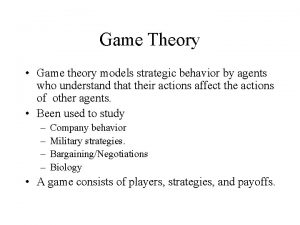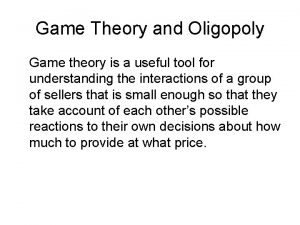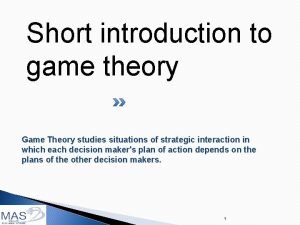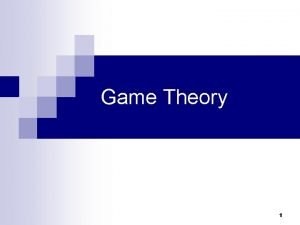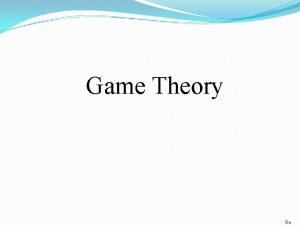Using Game Theory to Optimize Performance in a



























- Slides: 27

Using Game Theory to Optimize Performance in a Best-of-N Set Match Tristan Barnett Victoria University

Introduction When should an athlete break away from the leading pack in middle or long distance running? When should a tennis player serve-and-volley? When should the batting power-play in cricket be used? What height of the bar should an athlete choose in high jump or pole vault?

Introduction A best-of-3 set match is a contest where the first player to win 2 sets wins the match. Analyzing this system is non-trivial despite its relatively simple structure, because it is not certain that the third set will be played. Ferris (2003), Morris (1977), O’ Donogue (2001), Pollard and Noble (2002), Barnett et al. (2004), Pollard and Pollard (2007) and Brimberg et al. (2004) The above references are modelled where only one player makes all the decisions in the match. This talk will account for the interactive nature of tennis and analyze a best-of-3 set match where both players can apply an increase in effort on any set in the

Scenario a) Player A increases effort on one set from p to p + ε. On which set, should the player apply the increase to optimize their chances of winning? Player A has a constant probability p of winning the set. Probability of player A winning a best-of-three set match: Straight sets p 2 Win the last two sets Win the first and the last set (1 -p) p 2 p(1 -p)p 2

Scenario a) Current match score Match score at which an increase is applied Increase in probability of winning match (0, 0) (1, 0) (0, 1) (1, 1) ε 2 p(1 -p) εp(1 -p) ε 2 p(1 -p) (1, 0) (1, 1) ε(1 -p) (0, 1) (1, 1) εp εp (1, 1) ε

Scenario b) Player A increases effort on the first, second or third set player by ε, and decreases effort on the first, second or third set played by ε. On which sets, should the player apply the increase/decrease to optimize their chances of winning? Probability of player A winning a best-of-three set match = p 2(3 -2 p) + ε 2(2 p-1) When p>1/2, match win increases by ε 2(2 p-1) When p<1/2, match win decreases by ε 2(2 p-1)

Scenario c) Both players can apply an increase in effort at the first, second or third set played. On which sets should both players apply their increase to optimize their chances of winning? IA IB Probability of player A winning 0 0 p 2(3 -2 p) + 2 p(1 - p)( ε - α) 1 0 p 2(3 - 2 p) + 2 p(1 - p)( ε- α) + αε(2 p- 1) 0 1 p 2(3 - 2 p) + 2 p(1 - p)( ε- α) + αε(2 p- 1) 1 1 p 2(3 -2 p) + 2 p(1 - p)( ε - α) 2 0 p 2(3 - 2 p) + 2 p(1 - p)( ε- α) + αε(2 p- 1) 0 2 p 2(3 - 2 p) + 2 p(1 - p)( ε- α) + αε(2 p- 1) 1 2 p 2(3 - 2 p) + 2 p(1 - p)( ε- α) + αε(2 p- 1) 2 1 p 2(3 - 2 p) + 2 p(1 - p)( ε- α) + αε(2 p- 1) 2 2 p 2(3 -2 p) + 2 p(1 - p)( ε - α)

Scenario c) p 2(3 - 2 p) + 2 p(1 - p)( ε- α) + αε(2 p- 1) > p 2(3 -2 p) + 2 p(1 - p)(ε - α) → αε(2 p-1) > 0 →p>½ p 2(3 - 2 p) + 2 p(1 - p)( ε- α) + αε(2 p- 1) < p 2(3 -2 p) + 2 p(1 - p)( ε - α) → αε(2 p-1) < 0 →p<½ The stronger player benefits by both players applying an increase on different sets The weaker player benefits by both players applying an increase on the same set

Scenario c) Let X = p 2(3 -2 p) + 2 p(1 - p)( ε - α) and Y = p 2(3 - 2 p) + 2 p(1 - p) (ε- α) + αε(2 p- 1). Let strategy Ki (K: {A, B}, i : {1, 2, 3}) refer to player K applying an increase in effort at i sets played. B 1 B 2 B 3 A 1 X Y Y A 2 Y X Y A 3 Y Y X Mixed strategies of A: (⅓, ⅓, ⅓) and B: (⅓, ⅓, ⅓). The value (v) of the game is then ⅓X + ⅔Y. For example if p=0. 25, ε=α=0. 1, then X = 0. 15625; Y =

Scenario c) Conjecture: Suppose both players can apply one increase in effort in a best-of-N set match (N: odd integer). An increase in effort by ε at a set played from player A, results in increasing p to p + ε (p + ε < 1), and an increase in effort by α at a set played from player B, results in decreasing p to p - α (p - α > 0), where p represents the probability of player A winning a set. Then an optimal strategy for both players is to decide at the start of the match to apply the increase in effort with equal probability at N sets played, where the probability of applying the increase in effort at a set is given by 1/N. The value of the game is given by 1/N X + (N-1)/N Y, where X represents the probability of player A winning the match when an increase in effort by each player is applied at the same set played, and Y represents the probability of player A winning the match when an increase in effort by each player is applied at different sets

Applications From Scenario b), it is advantageous for the better player to vary effort whilst maintaining a mean probability of winning a set. Mulvey (2002) modelled the distribution of scores in golf from a selection of players. Their results showed that the lowest mean scores do not necessarily imply a greater chance of winning, since the standard deviation of players’ scores also contribute to the chances of winning. Variability can enhance performance.

Applications Tactical decisions in middle or long distance running on whether an athlete should break away from the leading pack. An athlete may be better off by increasing their variability by taking levels of risk, even though their overall mean performance may be better by not taking such levels of risk.

Applications Decision-making for choosing the height of the bar in pole vault is an important component for an athlete’s success. Athlete’s may be better off by increasing their variability by taking levels of risk, even though their overall mean performance may be better by not taking such levels of risk. At the 12 th IAAF World Championships, Steve Hooker won gold in the men’s pole vault by failing an initial starting height of 5. 85 and then cleared a height of 5. 90. Note that Hooker was carrying an injury and was limited to possibly one or two jumps.

Applications Initial starting height for the decision-maker. Height of the bar for each successive jump. Probability of obtaining the following for the decisionmaker by jumping at heights j, j+1 and j+2: Guaranteed First, Outright First and Guaranteed Second, Outright First and Guaranteed Third, Outright First………………. Variability and risk could also be applied to: The height of the bar in high jump

Applications From Scenario c), mixed strategies for both players should be applied where the probability for each set is equally likely. From Scenario a), the increase in effort can be applied by one player on any set to optimize their chances of winning Since a solution to Scenario a) is equivalent to the solution for Scenario c), then a player can be no worse off by analyzing Scenario c) - where both players/teams are optimizing their energy resources.

Applications Tennis players are known to use an occasional change-up tactic on serve as a surprise factor. This could involve a serve-and-volley or a slower paced first serve with heavy topspin. Randomizing this decision process could improve performance, based on the expectations of the opponent. Randomization could also be applied to: Batting power play in cricket Interchanging players in football When to pull the goalie in ice-hockey

References Barnett, T. , Brown, A. and Clarke, S. R. (2004) Optimal Use of Tennis Resources, In Proceedings of the 7 th Conference on Mathematics & Computers in Sport, R. H. Morton and S. Ganesalingam eds. , 57– 65. Brimberg, J. , Hurley, W. J. , and Lior, D. U. (2004) Allocating energy in a first-to-n match, IMA Journal of Management Mathematics, 15(1), 25– 37. Ferris, T. L. J. (2003) Emergence: An Illustration of the Concept for Education of Young Students, Proceedings of the Thirteenth Annual International Symposium of the International Council on Systems Engineering, Washington DC, 29 June-3 July, pp 945 -956. Morris, C. (1977) The Most Important Points in Tennis, Optimal Strategies in Sports, R. E. Machol (editor), 131 -140. Mulvey, J. M. , Green, W. and Traub, C. (2002) Team Selection by Portfolio Optimization, Science and Golf IV, E. Thain (editor), Routledge, London, 305 -316. O'Donoghue, P. (2001) The Most Important Points in Grand Slam Singles Tennis, Research Quarterly for Exercise and Sport No 2, 72 (2001), 125 -131. Pollard, G. and Noble, K. (2002) The Effect of a Variation to the Assumption that the Probability of Winning a Point in Tennis is Constant, 6 th Conference on Mathematics and Computers in Sport, G. Cohen (editor), Bond University, Australia, 227 -230. Pollard, G. N. and Pollard, G. H. (2007) Importances 2: The most important points in a tiebreaker game, and the most important games in a set, In proceedings of Tennis Science & Technology 3, S. Miller and J. Capel-Davies (eds. ), 293 -300.


IFORS 2011 Melbourne, July 10 -15, 2011 www. ifors 2011. org

Theme World OR : Global Economy and Sustainable Environment

About Melbourne A large modern city of over almost 4 million people but just over 170 years old It is located around Port Phillip Bay and sits over the Yarra River in southern Australia A cosmopolitan city which is the focal point of arts and sport in Australia Many things to do on times away from the conference with extensive theatre

Location

Venue Melbourne Convention Centre

Timing Southern Hemisphere Winter (mild) Easy access for post-conference travel to snowfields of Southern Australia or New Zealand or the Surf Coast or Barrier Reef in warm sunny Queensland or even trips to the interior or far north for something different!

Program The scientific program chair is Prof Janny Leung of the Chinese University of Hong Kong Streams and sessions are already being planned with over 60 people on the program committee already and more are very welcome! Contact addresses for the program committee are already displayed on the webpage The first formal call for papers will be issued soon and paper abstracts can be handled in about 6 months from now.

Topics The conference theme naturally lends itself to many OR topics concerning our role in making our environment safe and our use of all resources efficient. The program will naturally welcome papers from every area of Operations Research.

Sports in OR One or more streams on sporting applications of OR will be operating Sport is a big business and it draws on many areas of OR and applied statistics in the analysis of sports, scheduling of events and umpires, identifying optimal strategies, and other applications. Dynamic programming, math programming and simulation as well as heuristic approaches and statistical means have all been used effectively.
 Winter lagoon optimization
Winter lagoon optimization Loyalty spaarsysteem
Loyalty spaarsysteem It service management
It service management Sterile workflow optimization
Sterile workflow optimization Sql sucks
Sql sucks Disk usage by top tables
Disk usage by top tables Import np python
Import np python Salesoptimize reviews
Salesoptimize reviews Optimize plant availability
Optimize plant availability Abcde games
Abcde games Game lab game theory
Game lab game theory Liar game game theory
Liar game game theory Liar game game theory
Liar game game theory Game theory and graph theory
Game theory and graph theory The farm game board game
The farm game board game A formal approach to game design and game research
A formal approach to game design and game research Game performance assessment instrument
Game performance assessment instrument Game performance assessment instrument
Game performance assessment instrument Performance management vs performance appraisal
Performance management vs performance appraisal Performance levels
Performance levels 2018 jcids manual
2018 jcids manual The westing game introduction
The westing game introduction Jagged array
Jagged array Performance testing mobile applications using loadrunner
Performance testing mobile applications using loadrunner Performance evaluation using variances from standard costs
Performance evaluation using variances from standard costs Using system using system.collections.generic
Using system using system.collections.generic Accumulator ac
Accumulator ac Minimax and maximin principle in game theory
Minimax and maximin principle in game theory
